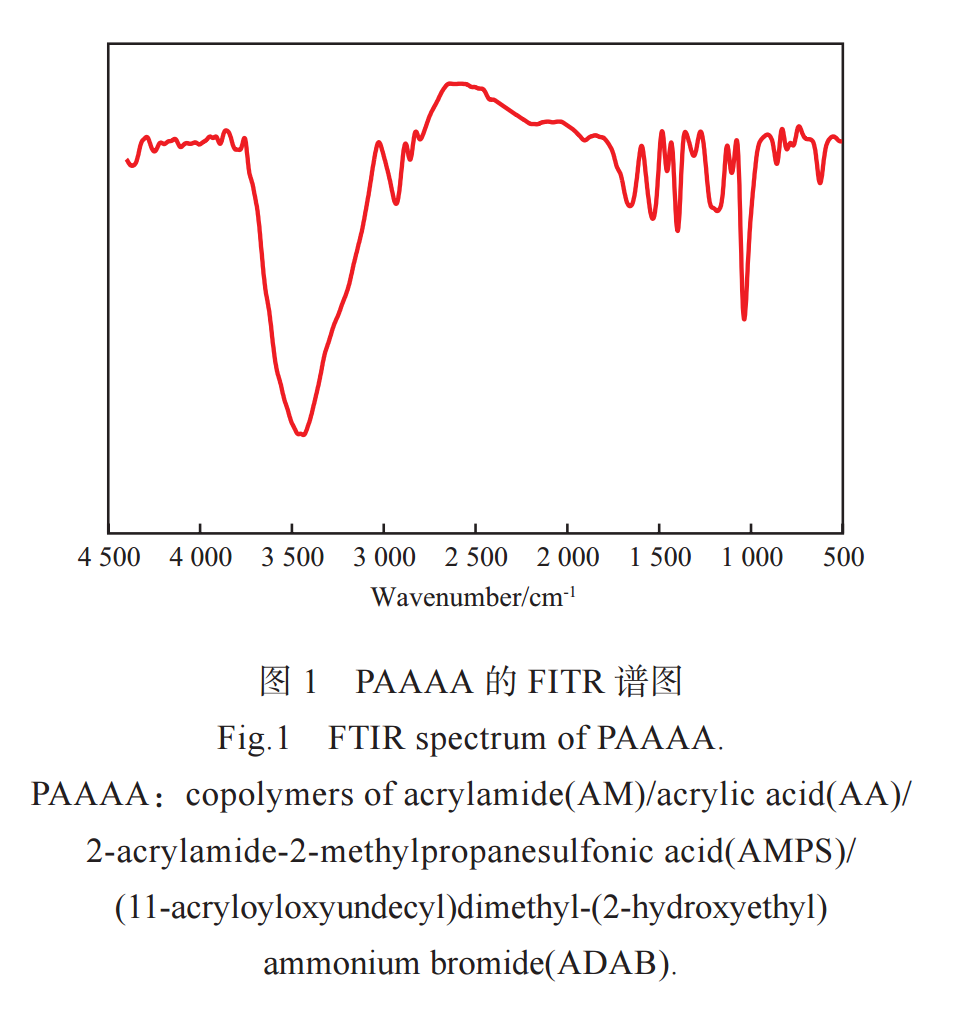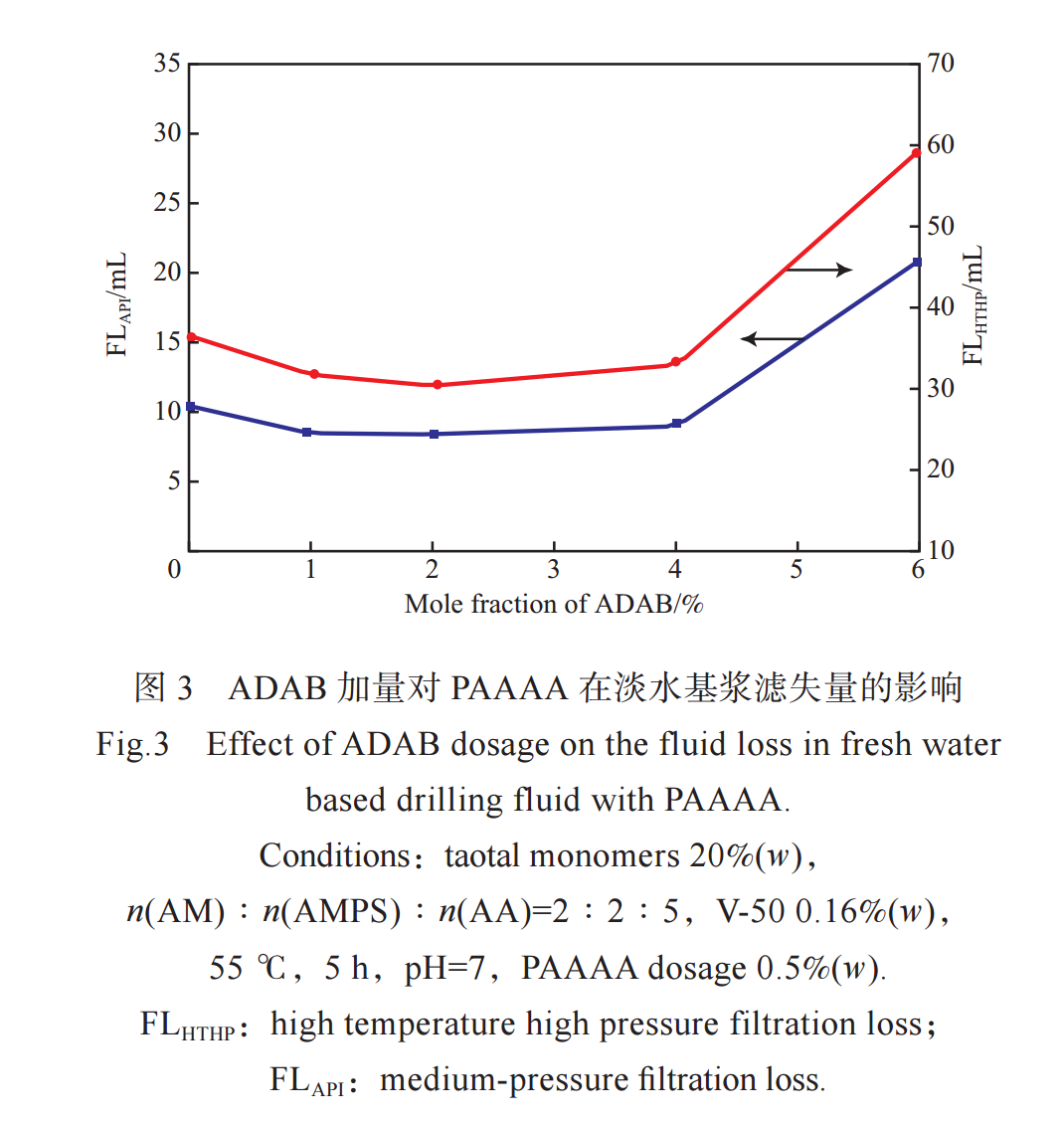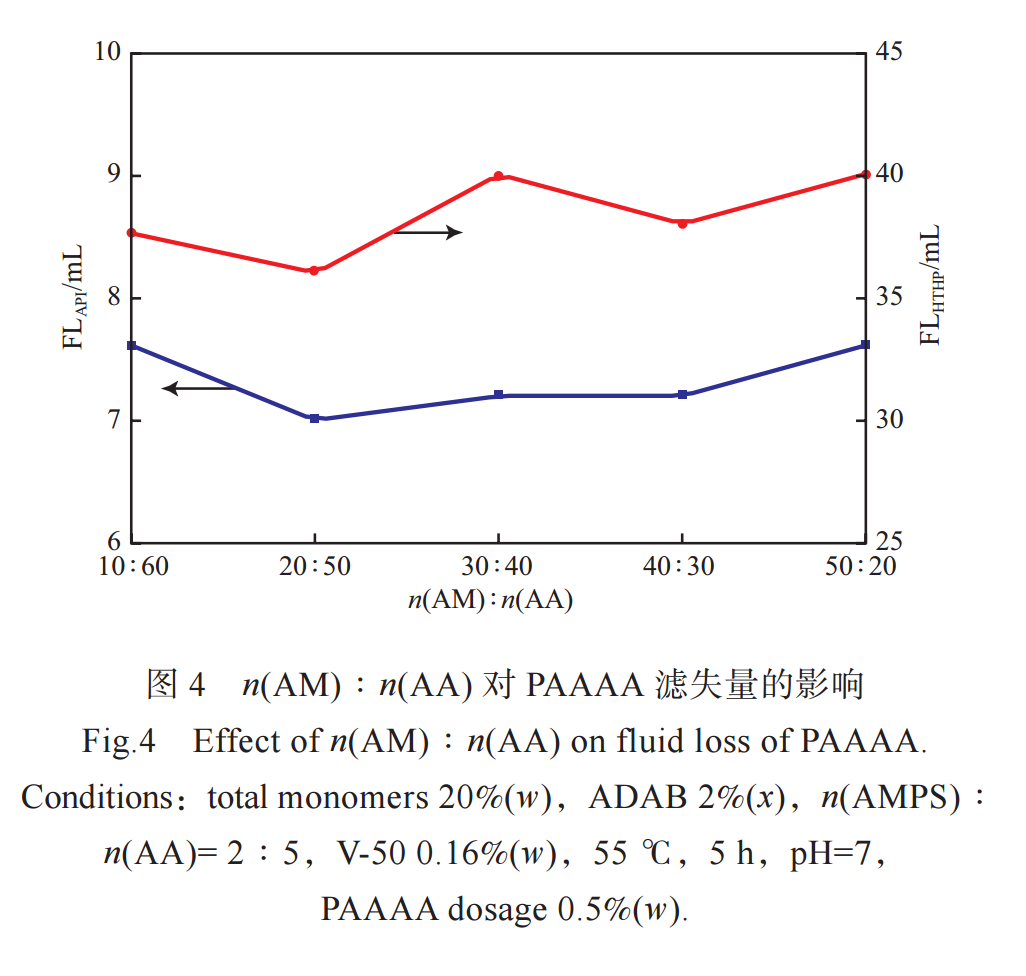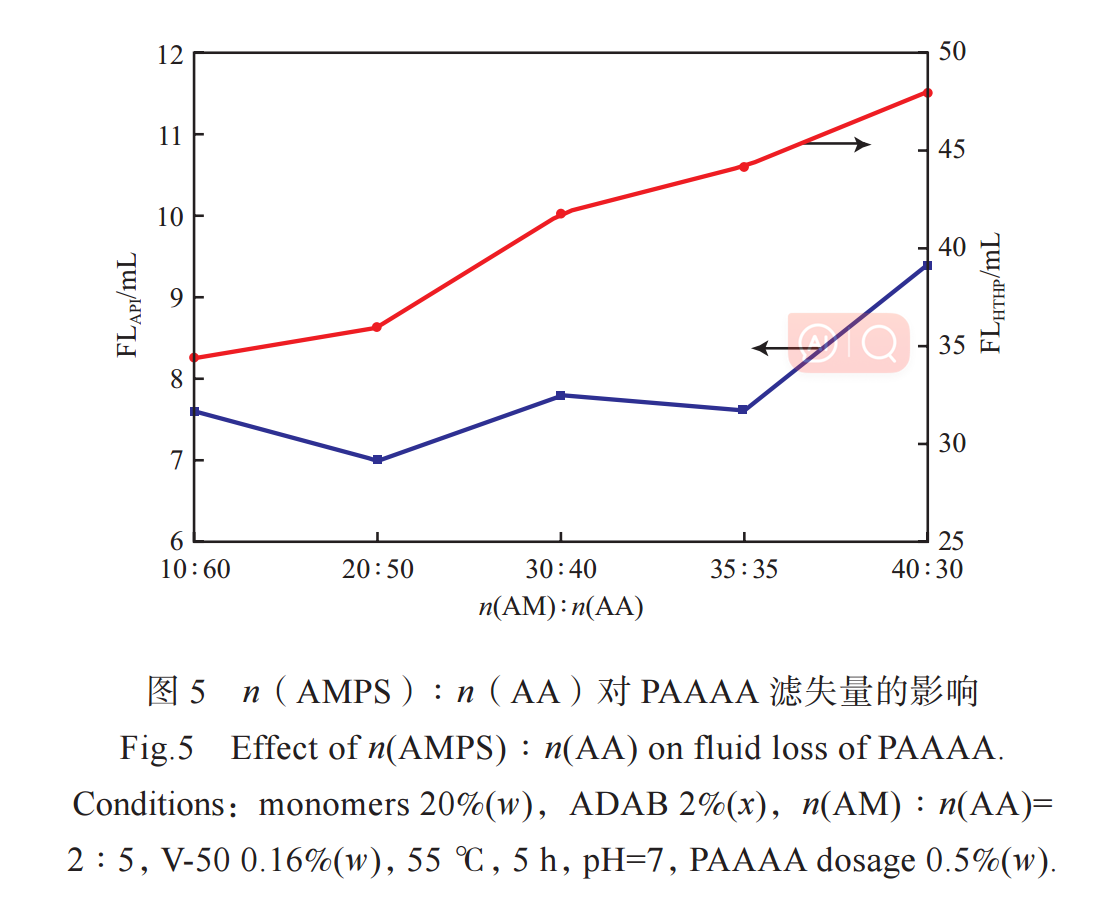Synthesis and Performance Evaluation of Polymer Fluid Loss Additive PAAAA(Part 1)
Abstract
A polymer fluid loss additive PAAAA was synthesized by aqueous solution polymerization,with acrylamide(AM), 2-acrylamide-2-methylpropanesulfonic acid(AMPS),acrylic acid(AA), and (11-acryloyloxyundecyl)dimethyl-(2-hydroxyethyl)ammonium bromide(ADAB) as monomers,2,2′-azobis(2-methylpropionamidine)dihydrochloride as initiator. The structure of PAAAA was characterized by FTIR and 1H NMR. Synthesis conditions were optimized by single factor method. The results showed that the optimum conditions were:n(AM)∶n(AMPS)∶n(AA)∶n(ADAB) =21.8∶21.8∶54.4∶2,the total monomer amount 20%(w),the initiator concentration 0.16%(w),reaction temperature 55℃,and reaction time 5h. When PAAAA content was 1.5%(w),themedium-pressure fluid loss(FLAPI) and high temperature high pressure fluid loss(FLHTHP) of saturated-brine based drilling fluid were 3.6 mL and 16.0 mL,respectively. After aging treatment at 200℃ for 16h,the FLAPI and FLHTHP of fresh water based drilling fluid were 9.0 mL and 26.8 mL,respectively. The PAAAA had excellent temperature resistance and salt tolerance.
With the continuous exploration and development of oil and gas towards deep formations, the problems of high temperature and high salinity faced in drilling engineering continue to increase. High temperatures can cause the failure of drilling fluid treatment agents, while salt intrusion can affect the performance of the drilling fluid and affect the progress of the drilling process. As one of the main treatment agents for drilling fluid, the structure and function of fluid loss agents play an important role in improving the performance of drilling fluid, stabilizing wellbore stability, and improving drilling efficiency. The existing fluid loss agents mainly include natural modification, synthetic resin, and synthetic polymer. Among them, natural modifications often use cellulose, starch, lignin, etc. as the main raw materials; Synthetic resins mainly use sulfonated phenolic resin as the main raw material; Synthetic polymers often use vinyl monomer copolymers as the main raw materials, such as acrylamide (AM), 2-acrylamido-2-methylpropane sulfonic acid (AMPS), acrylic acid (AA), methacryloxyethyl trimethylammonium chloride (DMC), dimethyl diallyl ammonium chloride, etc. To improve the temperature and salt resistance of polymers, it is possible to consider increasing the carbon chain length of cationic monomers. Our research team replaced the commonly used cationic monomer DMC with the long carbon chain quaternary ammonium salt monomer 11-Acryloyloxy undecyl dimethyl hydroxyethyl ammonium bromide (ADAB).
In this article, AM, AA, AMPS, ADAB were used as monomers, and 2,2'- azodiisobutylamine dihydrochloride (V-50) was used as initiator to obtain polymer fluid loss agent PAAAA through aqueous solution polymerization. The structure of PAAAA was characterized by FTIR and 1H NMR. And the reaction conditions for synthesizing PAAAA were optimized by measuring the filtration rate. The filtration performance of PAAAA in freshwater and brine was also investigated.
1. Experimental Part
1.1 Main Reagents and Instruments
l Anhydrous sodium carbonate, AA: Analytical pure, Chengdu Kelong Chemical Reagent Factory;
l AMPS, V-50: Analytical pure, Shanghai Aladdin Biochemical Technology Co., Ltd;
l Bentonite: Industrial grade, Xinjiang Central Africa Xiazijie Bentonite Co., Ltd;
l AM: Industrial grade, Jiangxi Changjiu Biochemical Co., Ltd;
l ADAB: self-made in the laboratory.
u ZNS-5A medium pressure filtration instrument: Qingdao Haitongda Special Instrument Co., Ltd;
u OWC-9508D high-temperature and high-pressure filtration instrument: Shenyang Petroleum Instrument Research Institute Co., Ltd;
u Zata PALS 190 Plus Zeta Potential and Particle Size Analyzer: Brookhaven, USA;
u WQF520 Fourier Transform Infrared Spectrometer: Beijing Ruili Analytical Instruments Co., Ltd;
u Bruker AVANE HD 400 nuclear magnetic resonance spectrometer: Brooke Company, Switzerland.
1.2 Synthesis of PAAAA
Add AM, AA, and AMPS to deionized water in a certain proportion, adjust the pH of the solution to 7 with sodium hydroxide, and then add ADAB. After blowing nitrogen for 30 minutes, add initiator V-50 and maintain a constant temperature for 5 hours at 55℃. Precipitate the reacted polymer solution with anhydrous ethanol and dry it to constant weight at 80℃ to obtain polymer PAAAA.
1.3 Characterization of the Polymer
FTIR characterization was performed using an infrared spectrometer and KBr compression method; 1H NMR characterization was performed using a nuclear magnetic resonance spectrometer.
1.4 Evaluation of Filtration Loss Reduction Performance
Add 0.24g anhydrous sodium carbonate and 4g bentonite to 100mL of fresh water, stir at high speed for 20 minutes, and maintain for 24 hours to obtain a fresh water base slurry. Add 35g of NaCl to 100mL of fresh water base slurry and cure for 24 hours to obtain a saturated saline base slurry.
Add the purified and dried PAAAA to the above base slurry, and measure the medium pressure filtration loss (FLAPI) (room temperature, 0.69 MPa) and high temperature and high pressure filtration loss (FLHTHP) (180 ℃, 3.5 MPa) according to the method specified in GB/T 16783.1-2014.
2. Results and Discussion
2.1 Characterization results
2.1.1 FTIR Characterization Results
Figure 1 shows the FTIR spectrum of PAAAA. From Figure 1, it can be seen that the stretching vibration absorption peak of the N-H bond is located at 3458 cm-1; The stretching vibration absorption peak of the methylene C-H bond is located at 2933cm-1; The absorption peak of the C=O bond in the amide group is at 1660cm-1; The absorption peak of carboxylic acid group -COO- is at 1536, 1402 cm-1; At 1186, 1039 cm-1, there is an absorption peak of the sulfonic acid group -SO3-; The stretching vibration absorption peak of C-N bond in quaternary ammonium salt is located at 627cm-1; No absorption peak was found at 1645~1620 cm-1, indicating no residual monomers.

2.1.2 1H NMR Characterization Results
Figure 2 shows the 1H NMR spectrum of PAAAA. From Figure 2, it can be seen that the chemical shift δ=1.43 corresponds to the methylene on the polymer carbon chain; δ=2.01 corresponds to the methylene group on the polymer carbon chain; δ=1.30 corresponds to the methyl group in AMPS; δ=3.06 corresponds to the methylene in AMPS that is connected to quarter C; δ=3.36 corresponds to the methyl group connected to N+in ADAB; δ=3.58 corresponds to the methylene group connected to N+in ADAB; δ=3.97 corresponds to the methylene group connected to oxygen atoms in ADAB; δ=1.60, 1.10 correspond to the methylene groups at both ends and in the middle of the carbon chain in ADAB,respectively. From the FTIR and 1H NMR characterization results, it indicates that the synthesized polymer molecular structure meets expectations.

2.2 Optimization of Synthesis Conditions
2.2.1 Impact of Monomer Ratio
Among the various factors that affect the performance of fluid loss agents, the monomer ratio is particularly important. Study the effect of monomer ratio on polymer filtration performance through single factor method.
2.2.1.1 The Effect of ADAB Dosage
As a cationic monomer, the addition of ADAB will affect the filtration performance of PAAAA in freshwater based slurries. Figure 3 shows the effect of ADAB dosage on the filtration loss of PAAAA in freshwater slurry.
From Figure 3, it can be seen that with the increase of ADAB dosage, FLAPI and FLHTHP show a trend of first decreasing and then increasing. When the dosage is 2% (x), the minimum FLAPI is 8.4 mL and the minimum FLHTHP is 30.4 mL. When the dosage exceeds 4% (x), both FLAPI and FLHTHP significantly increase. This is because ADAB has a strong adsorption capacity for clay particles when the amount of ADAB is less, but when the amount of ADAB is more than 4% (x), PAAAA is easy to form gel and its water solubility is reduced. Therefore, the appropriate dosage of ADAB is 2% (x).

2.2.1.2 The Effect of n(AM)∶n(AA)
The adsorption and hydration groups in the molecular structure of PAAAA affect the adsorption and hydration performance of PAAAA with clay particles. The amide group in AM forms hydrogen bond adsorption with clay. AMPS and AA have sulfonic and carboxylic groups, respectively, which can form a hydration film on the surface of clay, enhance the negative charge of the clay surface, thereby improving the stability of clay particles and making them better dispersed in water.
Figure 4 shows the effect of n (AM): n (AA) on the filtration performance of PAAAA in freshwater based slurry. As shown in Figure 4, with the increase of n (AM): n (AA), FLAPI and FLHTHP show a trend of first decreasing and then increasing. When n (AM): n (AA)=20:50, the minimum FLAPI is 7.0mL, and the minimum FLHTHP is 36mL. This is because the increase in AM content leads to an increase in the relative molecular weight of the polymer. However, the decrease in the hydration group AA reduces the negative charge on the surface of clay particles, weakens the repulsive force between clay particles, and makes it easy for particles to coalesce. Small particles become large particles, leading to an increase in filtration loss. Therefore, it is more appropriate to choose n (AM): n (AA)=20:50.

2.2.1.3 The Effect of n(AMPS)∶n(AA)
AMPS has good stability and is not sensitive to temperature and ions. It is commonly used as a temperature and salt resistant monomer. AA has good hydration performance, but insufficient salt resistance. Figure 5 shows the effect of n (AMPS): n (AA) on the filtration performance of PAAAA in freshwater based slurry. From Figure 5, it can be seen that with the increase of n (AMPS): n (AA), FLHTHP keeps increasing, while FLAPI first decreases and then increases. This is mainly because the AMPS group is large, resulting in a significant steric hindrance effect. When the content is too high, it will reduce the relative molecular weight of the polymer, leading to an increase in filtration loss. However, AMPS has hydration and sulfonic acid groups, which have stronger negative charge than carboxylic acid groups. It can form a thicker hydration film on the surface of clay, enhance the electronegativity of clay particles, and resist the compression of salt on the double layer of clay surface. In order to improve the temperature and salt resistance performance of PAAAA, it is more appropriate to choose n (AMPS): n (AA)=20:50.
In summary, the appropriate monomer ratio is determined to be n (AM): n (AMPS): n (AA): n (ADAB)=21.8:21.8:54.4:2.

